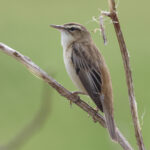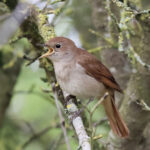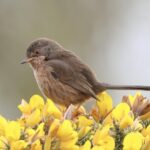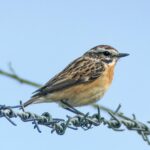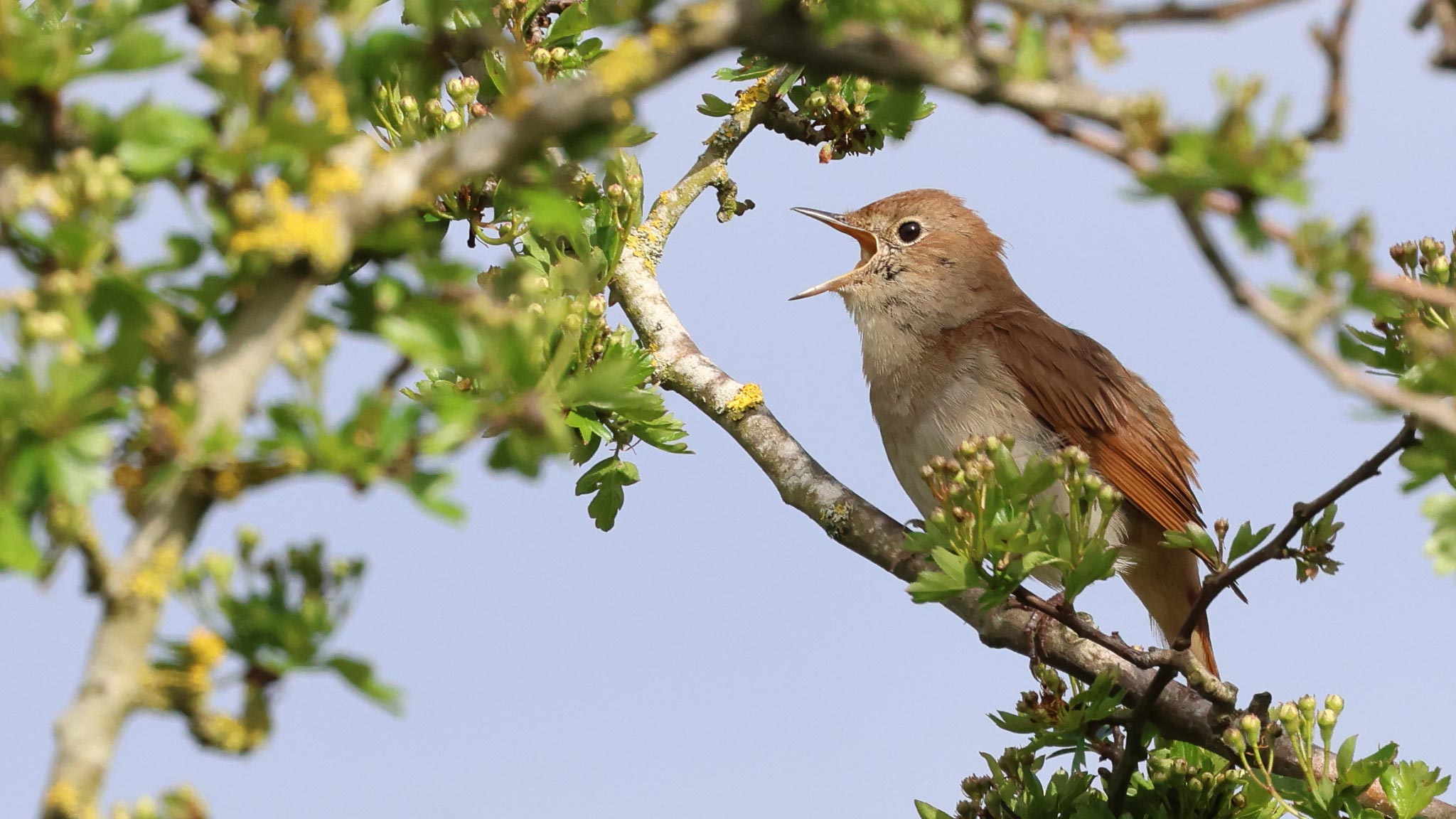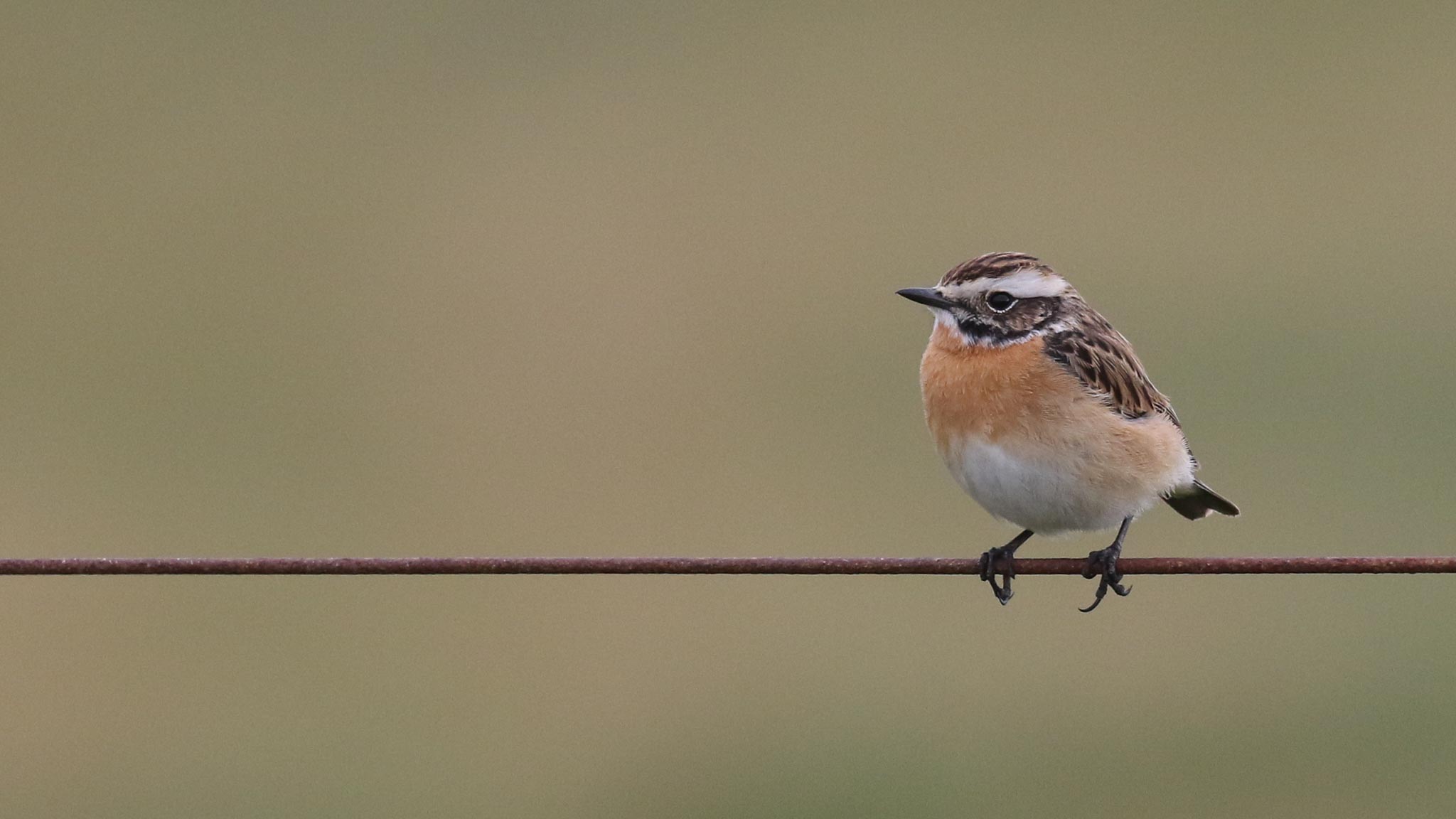Day 1 of three days of Private Tours today in Norfolk, some gentle days of general birding and other wildlife. It was a cloudy start to the day, but the cloud gradually burnt back to the coast and then it was mostly bright and sunny. It was warm, but a moderate NE wind on the coast kept the temperatures down a bit.
Given the weather, we headed straight up to the Heath first thing this morning. As we got out of the car, a Willow Warbler was singing in the car park and we could hear two Yellowhammers singing too up along the path. As we walked over that way, we had a good look at one of the Yellowhammers in the scope, perched in the top of a birch tree. A little further on, and a Chiffchaff was singing too.
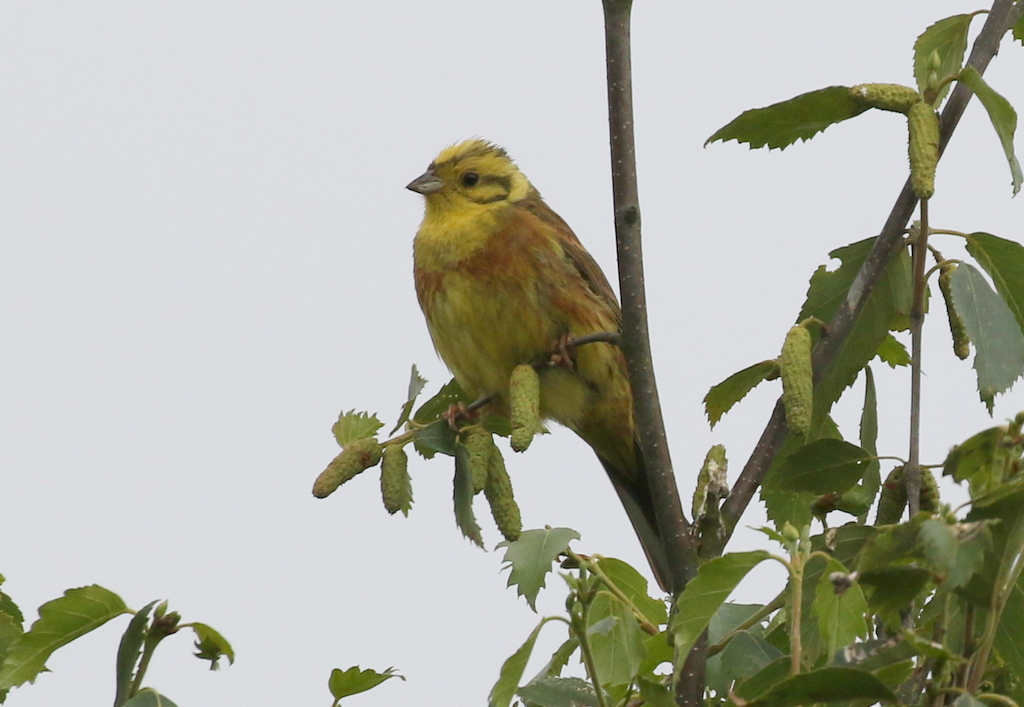
As we walked up along a big sandy track, two Woodlarks flew up from the vegetation beside the path. Unfortunately they flew round past us and disappeared off over the trees, dropping down again over the other side. Still, it was a nice flight view and we could see their short tails as the passed.
There were several Linnets perched up on the fence here and we got a smart red-breasted male in the scope. While we were looking at them, we noticed a female Stonechat perched on a bush behind. We got the scope on it, but it dropped back into the vegetation before everyone could get a look at it.
Turning the corner on the path, another Woodlark flew up calling from the heather nearby. This one circled round and landed in the top of a pine tree a little further back. It was nice to see this one perched, but again it wouldn’t stop for photos though and dropped down after we had managed a quick look at it through the scope.
Our main target here was Dartford Warbler and a little further along the path we stopped by some gorse and were quickly rewarded. We heard one calling and looked across to see a male Dartford Warbler hop up into the top of a bush. It was busy looking for food, climbing round in and out of the vegetation. Then a second Dartford Warbler appeared next to it, the female.

We stood here and watched the Dartford Warblers for a while, from a discrete distance away. They were both busy collecting food, hopefully with some hungry youngsters to feed nearby. They were remarkably obliging today, perching up in the top of the gorse, often close to each other. After a few minutes they flew across to a more dense patch of gorse and disappeared from view. We decided to leave them in peace.
There were lots of butterflies out today on the heath, particularly as the clouds started to burn off. A small skipper which flew around in the vegetation by the path turned out to indeed be a Small Skipper once we got a good look at it (sufficient to distinguish it from the very similar Essex Skipper).
Most of the butterflies were blues, in particular Silver-studded Blues which are one the specialities of the heath here. On the way back to the car, we stopped by an area which is particularly good for them at the moment, and saw lots of males flying and several mating pairs too. As we got back to the car park, a Garden Warbler was singing from deep in the blackthorn bushes.
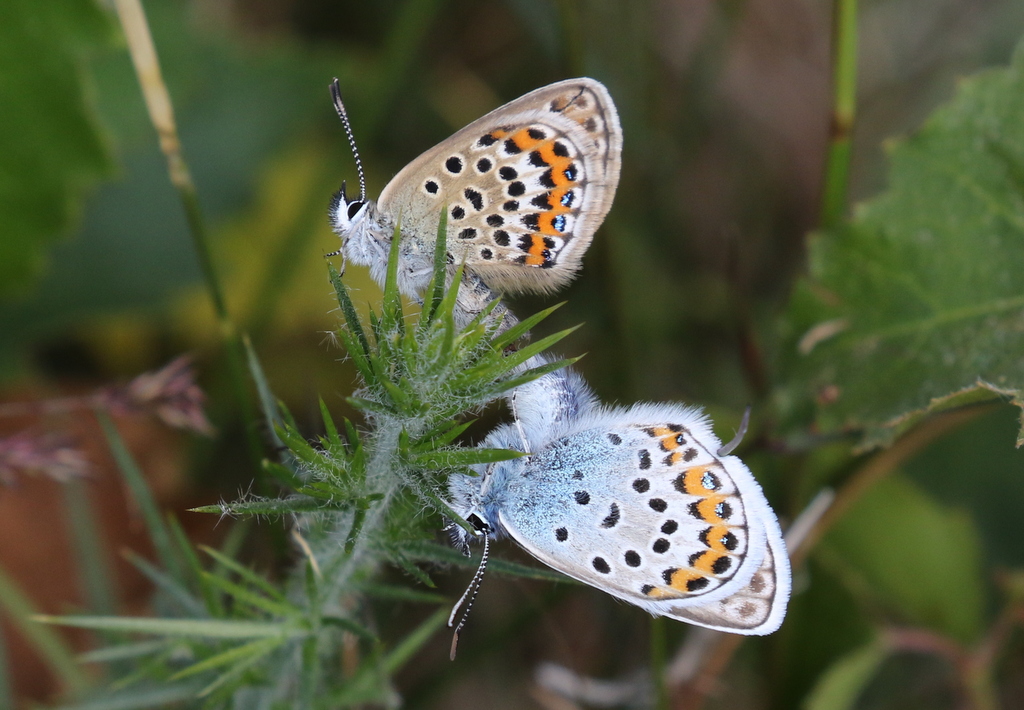
Sometimes it is possible to find Nightjars roosting during the day, so next we headed over to another location where we have seen them recently, to try our luck. The vegetation is getting very high now, which makes them harder to see, but the first place we looked we could just make out a shape down on the ground in amongst the bracken.
It was a male Nightjar. We got the scope on it and everyone took a look, being very careful not to disturb it. They are incredibly well camouflaged and it was relying on its cryptic plumage to think that we couldn’t see it. After we had all had a good look at it, we backed off very quietly and left it where it was.
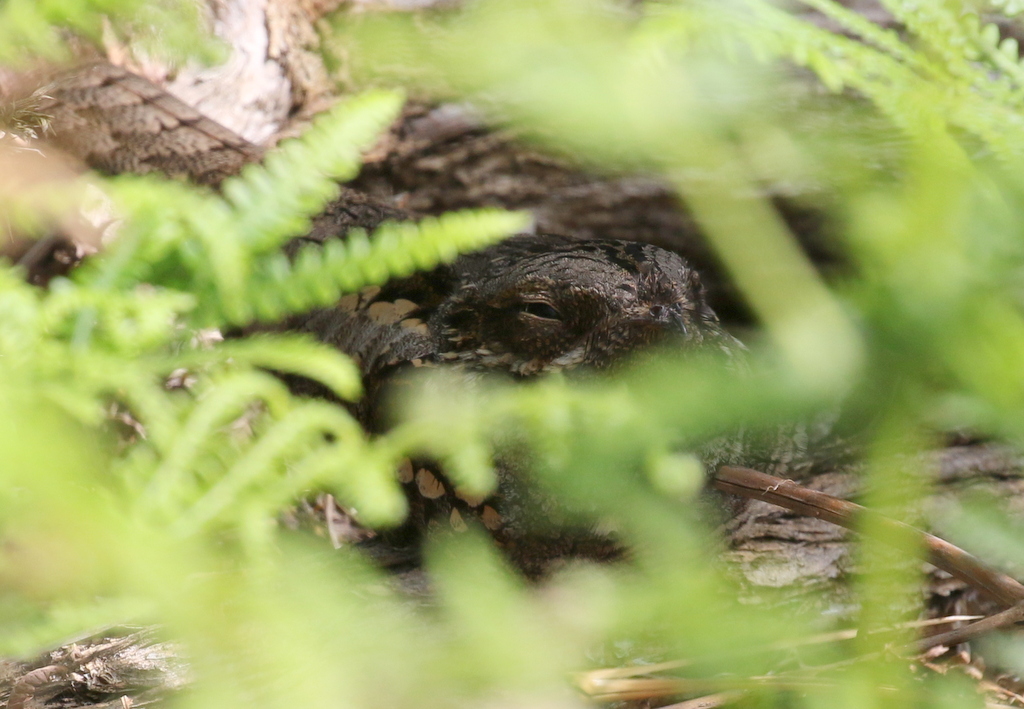
It had been a very successful morning, exploring the heaths of North Norfolk, so we decided to head down to the coast for a change of scenery. We still had enough time for another quick walk before lunch, so we made our way down to the East Bank at Cley.
It was a bit breezy up on the bank. We heard a couple of Reed Warblers singing, but they were keeping well tucked down in the reeds here. A Sedge Warbler was more obliging, climbing up into the dead branches of a small bush out in the reedbed, where we could get it in the scope.
Bearded Tits don’t like the wind, so it was perhaps not a surprise that they were rather elusive today. We heard a couple pinging and managed to see one juvenile come up to the top of the reeds briefly, but it flew before everyone could get onto it.
There were not so many dragonflies and butterflies out here today, in the cool breeze. We did see a Common Darter though, the first we have seen this year. The Common Swifts were enjoying the wind, zipping back and forth low over the reeds.
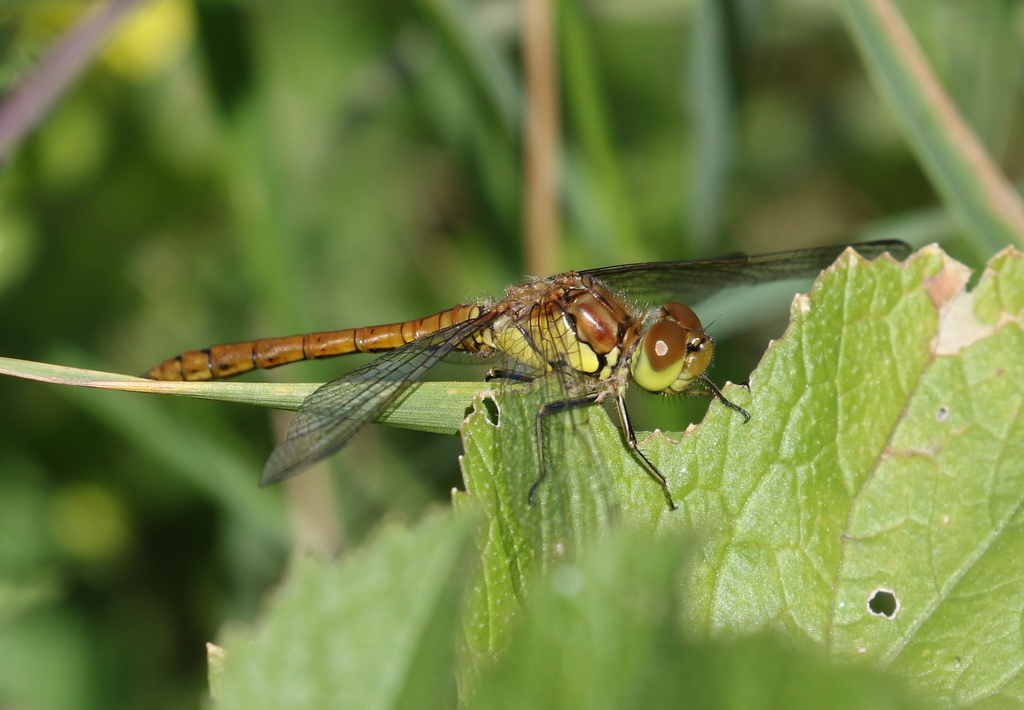
With the breeding season well advanced now, there are not so many birds out on the grazing marshes now. We did find a couple of Lapwing and an Avocet. A single Ruff on the Serpentine was tucked down asleep, but did wake long enough to raise its rusty head. This is most likely a returning migrant, having already been north for the breeding season, and it was already well advanced in its moult, with a very scrawny neck where its ornate ruff would have been just a few weeks ago.
The ducks are starting to moult into their duller eclipse plumage too now – we got a moulting drake Gadwall in the scope, starting to look a bit tatty. There were still plenty of Greylags and a few Canada Geese though. A couple of Grey Herons were busy preening over by the reeds at the back.
We carried on up to Arnold’s Marsh, past a Skylark and a Meadow Pipit both still singing and songflighting, and took advantage of the shelter to rest our legs. The first bird which immediately stood out was a Spoonbill, standing in the middle of the water at the back. It was doing what Spoonbills like to do best – sleeping! It did wake up a couple of times, just long enough to flash its distinctive bill, before tucking it back in again.

There were a few terns on here too, though not as many as usual. We could see five Sandwich Terns preening on one of the islands and a single Little Tern resting on a patch of shingle. There were not too many waders either today, a few Redshank and Lapwing and a single Turnstone and one Oystercatcher right out at the back.
We couldn’t come all this way and not at least look at the sea, but there was not much to see offshore today. A few Little Terns were diving into the water, some way out today. We decided to head back.
On the walk back, we heard the Avocets alarm calling out on Pope’s Marsh and turned to see a male Marsh Harrier heading our way, with an Avocet or two in pursuit! The Marsh Harrier crossed the path and headed out across the reedbed, before circling and starting to lose height. It seemed to circle for a while, but there was no sign of the female coming up to accept a food pass, so eventually the male dropped down into the reeds himself. A Sparrowhawk flew past over the reedbed at the same time.
We wanted to make use of the picnic tables at the visitor centre for our lunch, but when we got round there a school party had taken over every table, with only 2-3 people at each one. Plan B was to head round to the shelter in the beach car park instead, which had the added bonus of being out of the wind. After lunch, we drove back to the visitor centre and made our way out onto the reserve, stopping briefly to admire the single Broomrape spike by the path.
There were one or two Reed Warblers singing in the reeds by the path, but they were impossible to see through the vegetation. When we got to the bridge over the ditch, we stopped to look back along the water. We could see one or two Reed Warblers zipping back and forth between the reeds either side.
Eventually a couple of the Reed Warblers came much closer to us and we could see that it was an adult with a recently fledged juvenile begging for food. We watched as the adult caught a damselfly and fed it to the youngster, before the two of them disappeared back into the reeds.

We made our way straight out to Dauke’s Hide and had a look on the scrapes. There were a couple of Little Ringed Plovers running around on the front edge of the first island on Simmond’s Scrape, chasing after the juvenile Pied Wagtails.
There were a few Black-tailed Godwits out on the scrape too, one of which was wearing a large quantity of coloured plastic rings. A closer look confirmed that it was the same bird that we had seen a few days ago, a Continental Black-tailed Godwit of the nominate race, limosa, much scarcer than the more regular Icelandic Black-tailed Godwits it was with.
We have had the data back already for this particular Continental Black-tailed Godwit already. It was ringed in May last year, on the Nene Washes in Cambridgeshire, where it bred. It was also seen last year along the North Norfolk coast, at Titchwell and then Cley, from mid June to early August. It is also bearing a geolocator which monitors its location and allows the researchers to track its movements and this had shown that it spent the winter down in West Africa. Apparently it bred again at the Nene Washes this year.
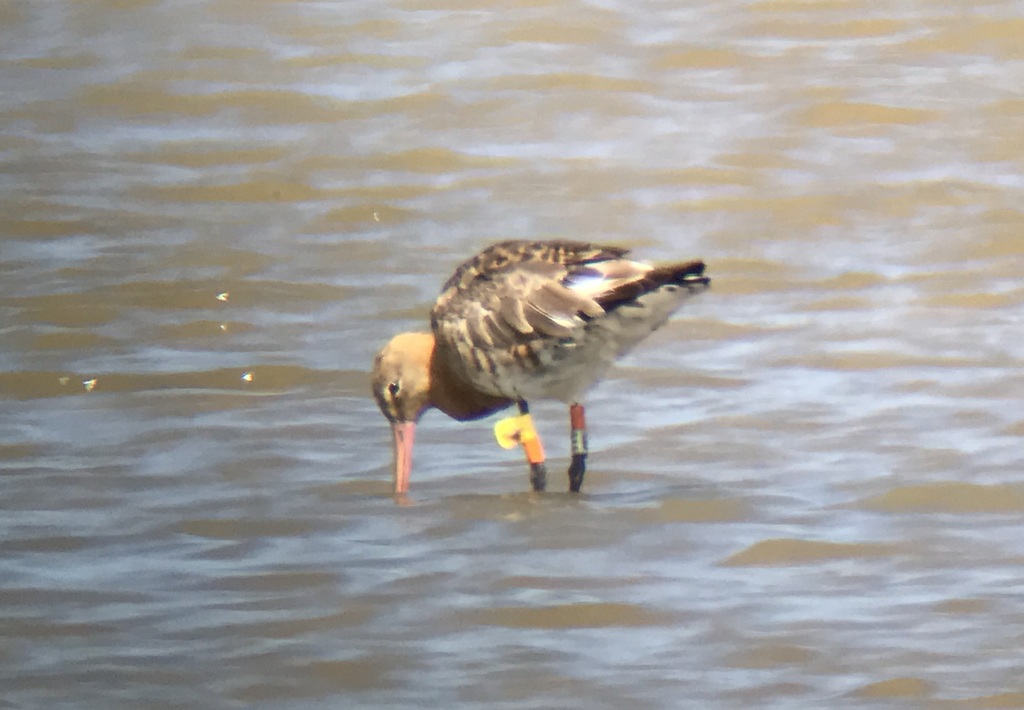
There are lots of Avocets on the scrapes here at the moment – it looks like it has been a good breeding season for them here. There were a couple of large gatherings of loafing birds out on Pat’s Pool. One of the adults on Simmond’s Scrape was still busy chasing away any birds which came close, mostly ducks, despite it not having any youngsters to protect.
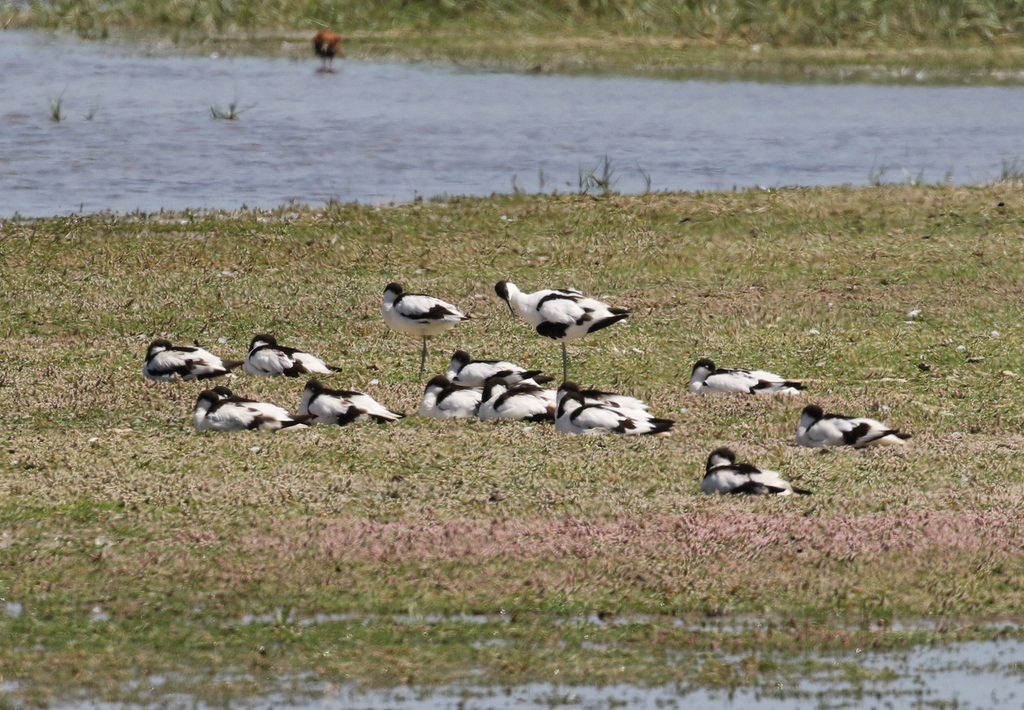
Behind the Avocets, we could see several more Ruff. Again, they were busy moulting, with tatty looking necks where they have already started to lose their ornate ruff feathers. There are quite a few Teal on here already too, returning birds from further north, where they breed, and they are also quickly starting to moult into eclipse plumage. It really is the end of summer for many of the birds already!
There were a few gulls around the scrapes too, mostly Black-headed Gulls but also a few Lesser Black-backed Gulls and a single Common Gull. There were no Spoonbills on the scrapes from the hides today though, but we did see one fly over and land out on Billy’s Wash, out towards the beach.
A quick look in on Avocet Hide revealed a Green Sandpiper sleeping on the edge of the closest island. It woke up as we opened the flaps of the hide and stood looking at us for a while, before flying back to the next island over and starting to feed along the muddy margin. Another autumn migrant stopping off on its way back south after the breeding season.

It had been a very productive day, but we decided it was time to call it a day and head back now. Let’s see what tomorrow brings…
